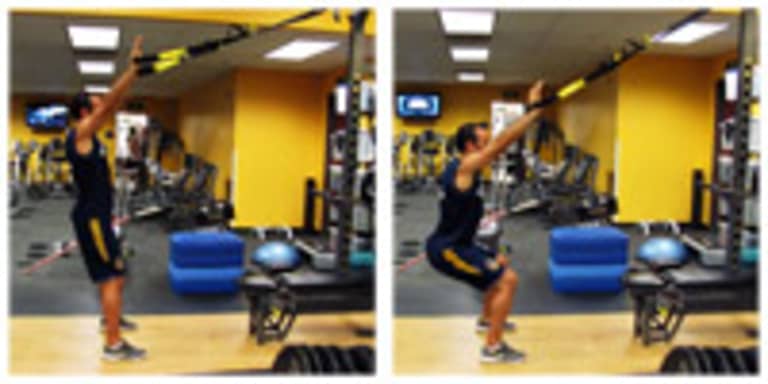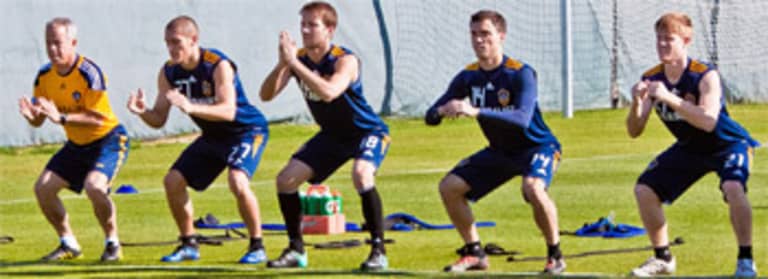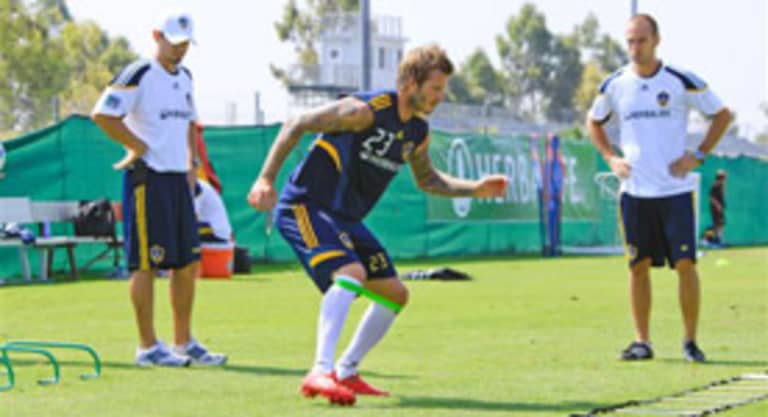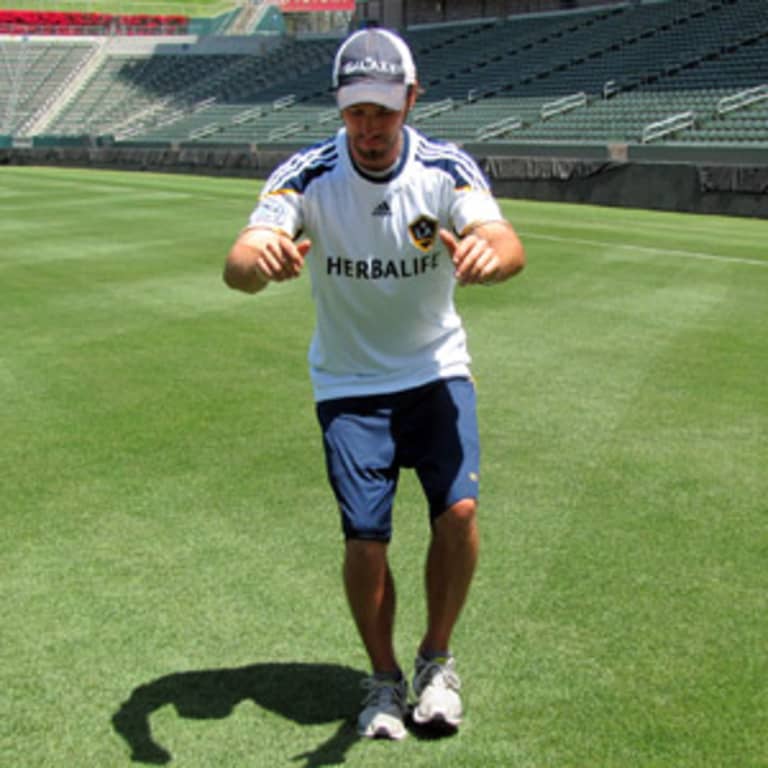Last week, we introduced a movement screen that we use with the players, called the Functional Movement Screen (FMS). As we mentioned, the FMS is a series of seven different exercises that allow us to analyze how the body is moving and consequently adjust the players’ lifting and injury prevention programs based off of how well they perform the exercises and if they are feeling pain with any of them.
READ: Fitness Screening to improve performance and prevent injuries
Over the next couple weeks, we are going to break down the exercises in the FMS, showing some of the common form errors and then look at the different exercises that we incorporate into our programs in the gym and on the pitch to address any imbalances, dysfunctions and asymmetries.
DEEP SQUAT

Click to enlarge
Error #1: Knees over Toes
<p style="text-align: center;"><strong><em><img alt="" src="https://losangeles-mp7static.mlsdigital.net/mp6/kneesforward_350x350jpg.jpg" style="vertical-align: middle; border-top-width: 0pt; border-right-width: 0pt; border-bottom-width: 0pt; border-left-width: 0pt; border-top-style: none; border-right-style: none; border-bottom-style: none; border-left-style: none; border-color: initial; width: 200px; height: 200px; "></em></strong><br><br><span style="font-size: x-small;"><em>Incorrect Form</em></span></p> |
<p>One of the most common errors we see with the Deep Squat is the players’ inability to sit into their hips and the tendency to drive their knees forward. (pictured above) When the knees are in front of the toes, all the weight and forces go straight into the knees and prevent the hips and glutes from functioning the way they should. When we see this from the players, we have a number of corrective exercises in the gym and on the pitch that we have them perform to help correct the problem.</p> |
In the gym
Whenever the Galaxy players lift, there are a few corrective exercises that we have them perform at the start of every lifting session to correct their movement patterns. The two exercises below help them develop better hip mobility, teach them how to sit into their hips and let the hips work more during the squat, also relieving their weight from going into their knees.
Exercise #1: Deep Squat Progression with Heel Lift
How to Perform the Exercise: Place a lift under your heels. (see image sequence below for heel lift placement) Holding a 5-pound weight, squat down, maintaining a flat back without your heels coming off the lift. While still in the squat, set the weight down on a bench and extend one arm overhead, then the other, and stand back up. Do 2 sets of 10 reps. With time, you should be able to reduce the height and eventually get rid of the lift.

Click to enlarge
Exercise #2: TRX Deep Squat
How to Perform the Exercise: Hold the TRX overhead and stand with your feet shoulder width apart. Squat down keeping the TRX overhead. The slight pressure on the TRX should help with your balance and allow you to sit deeper into your hips. Do 2 sets of 10 reps.

Click to enlarge
On the Field
When decelerating on the pitch it is very important to let the hips and not the knees do the majority of the work. If a player drives his knees forward during the Deep Squat screen, we might see some of those same issues when starting and stopping on the field. The below exercise is one we do with the players on the pitch to help with their squatting and decelerating pattern.
Exercise: Drop Squats
How to Perform the Exercise: Start with feet shoulder width apart. On a cue from a coach or fellow player, drop into your base squat position as quickly as you can, remembering to keep the weight on the balls of your feet and your hips moving down and back so that the knees stay over or behind the toes. Do 3 sets of 6 reps.

Error #2: Knees Fall In
<img alt="" height="200" src="//losangeles-mp7static.mlsdigital.net/mp6/kneein_350x350.jpg" style="vertical-align: middle; border: 0pt none;" width="200"><span style="font-size: x-small;"><em>Incorrect form</em></span> |
<p>The other big issue that we see with a lot of the Galaxy players is the inability to keep their knees from caving or falling in while keeping them over their toes. (Pictured above) If their knees fall inwards or toward each other it is usually a result of not having proper glute strength, as the glutes control our ability to stabilize the rotation of the femur and therefore where our knee moves. </p> |
In the Gym
Here are two gym exercises the Galaxy players perform to help build the strength necessary to prevent their knees from caving in during the Deep Squat:
Exercise #1: Side-Lying Clam Shells
How to Perform the Exercise: Lie on your side with legs bent. Without letting your hip rotate, lift your top knee off the ground. This exercise will focus on strengthening the glutes, which will help stabilize and control the rotation of the legs. Do 2 sets of 10-20 reps.

Click to enlarge
Exercise #2: MiniBand Deep Squat
How to Perform the Exercise: This exercise goes through the same motion as the Deep Squat Progression with Heel Lift (see description above), but with a miniband around the knees instead of with a lift under the heels. The miniband tries to force the knees in even further and requires active resistance against it to prevent the knees from caving in. So, pushing against the miniband will help strengthen your glutes and improve squatting posture. Perform 2 sets of 10 reps.
Deep Squat Progression (use motion below, but remove heel lift and add miniband)
<p><a href="/sites/losangeles/files/heellift.jpg" target="_blank"><img alt="" height="100" src="//losangeles-mp7static.mlsdigital.net/mp6/heellift_small.jpg" style="vertical-align: middle; border: 0pt none;" width="400"></a><br><span style="font-size: x-small;"><a href="/sites/losangeles/files/heellift.jpg" target="_blank">Click to enlarge</a></span></p> |
<p style="text-align: center;"><a href="/sites/losangeles/files/mini-band.jpg" target="_blank"><img alt="" height="100" src="//losangeles-mp7static.mlsdigital.net/mp6/miniband_small.jpg" style="vertical-align: middle; border: 0pt none;" width="100"></a><br><span style="font-size: x-small;"><a href="/sites/losangeles/files/mini-band.jpg" target="_blank">Example Miniband Placement - Click to enlarge</a></span></p> |
On the Field
Again, whenever the players decelerate and change direction it is important that they drop through the hips and not let the knees cave in. These next two exercises help with cutting and changing direction on the pitch:
Exercise #1: Miniband Lateral Walks

How to Perform the Exercise: Start in base squat position with a miniband just above the knees. Maintaining that position, push with trail leg and take a step to the side, returning to your base position. Do 1 set of 10-15 yards in each direction.
Exercise #2: Single Leg Drop Squat (with mini band)

How to Perform the Exercise: Same starting position as drop squat above but this time on the cue drop down onto one leg, balancing and controlling your knee so that it stays over your feet. Do 3 sets of 6 reps on each leg. Add a mini band if needed to control knee from dropping in.
These are just a few examples of the issues we find when looking at these screens as well as some simple exercises we use in the gym and during our warm up on the pitch to help try and correct them. Ultimately if we want to be healthy, injury free, and productive on the pitch, we need to take care of our bodies and correct some of these bad habits in order to be able to run, jump, and cut when we are playing.
Next week we will look further at a few of the other Functional Movement Screens.
Have questions about anything you read in this article? Want to learn more? Leave Ben a question below, tweet it to him @byauss1 or email socialmedia@lagalaxy.com.
Follow all of Ben's Galaxy Fitness Insider updates at www.lagalaxy.com/fitnessinsider. Fans are encouraged to participate by leaving questions for Ben at the bottom of each article, which he will aim to incorporate into these weekly posts.


